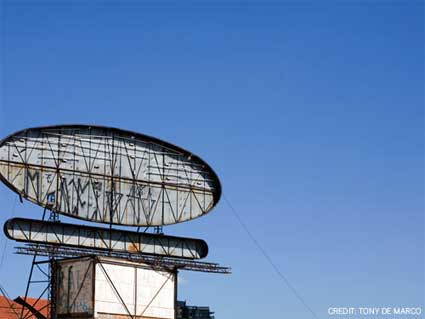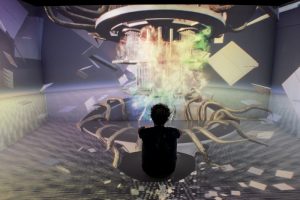Back in November i was at Medialab Prado in Madrid to visit the Visualizar workshop and i had the pleasure to hear the talk that Juan Freire gave there. I was really looking forward to know better about the thoughts of someone whose keen observation on open knowledge, digital culture and everyware’d city i was following with interest for some time. Juan Freire is one of the very very few people who keep track of what is written in the field of ubiquitous computing, free software and technology but who would also hang around with media art curators and mingle with the hackers and the urbanists. And his everyday job doesn’t have much to do with all of the above. He has a PhD in Biology, he is Associate Professor and Coordinator research group at University of Corunna. As a leader of the research group in Marine Resources and Fisheries, he was involved in several R+D projects. He collaborates with businesses, public organizations and NGOs in topics related to sustainability and environmental management. He is CEO of Fismare, an environmental consulting firm. There’s more but i’m starting to be convinced that there are hyper-active clones of Freire all over Spain.
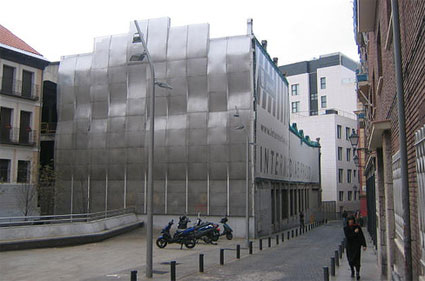 Exterior of Medialab Prado
Exterior of Medialab Prado
His blogs are in spanish: there’s Piel digital (Digital skin), nomada and Ciudades enredadas (Networked cities). And obviously his talk was in spanish as well but i found it so inspiring that i’ve dutifully spent a few hours translating it. I hope you will enjoy reading it as much as we all enjoyed listening to it in Madrid.
That November evening in Madrid, Juan Freire shared with us his thoughts about public space, whether it is obsolescent or necessary, what is the meaning of the expression in the 21st century, and what could happen should public space as we know it disappear.
The video of his presentation is online and in spanish, and so are the slides of Juan’s talk. But the excerpt of his talk is here (and in english).
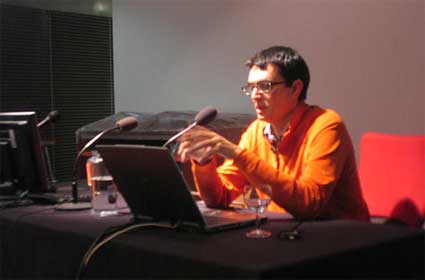
The issues he made us reflect upon that evening were:
1. What are the commons?, What is the pro-common?
2. Do public spaces suffer from a Tragedy of the Commons or from a Tragedy of the Anti-Commons?
3. Post-modern public space
4. Do public spaces still exist?
5. The hybrid public spaces of the net society
6. The future of hyperlocal networks
7. The hidden face of the hybrid public spaces.
Freire started with a tour of what the term Commons means today. The term sounds rather old-fashioned and probably most people wouldn’t feel comfortable defining it today. It’s something that comes right from Medieval Times but do the Commons still play a role in our life today? Is it limited to natural resources? Couldn’t internet be also part of the Commons? And digital knowledge? Public Spaces? What happens when we put side by side a series of elements which seem to be distinct but are getting increasingly connected such as internet, knowledge and public spaces? Juan Freire’s talk tried to explore some of those issues and bring a few answers.
What will the future bring? There are two scenarios, two alternatives of a possible future. Each of these scenarios will be more or less viable depending on many circumstances, one of them being the way we regard our role as citizens:
– we behave passively and accept the future as it comes.
– we decide that we can take an active role and grab the opportunity to participate to the shaping of our future.
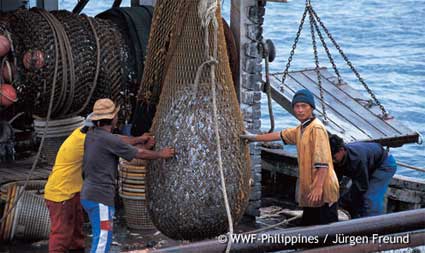 Photo WWF
Photo WWF
Besides the Commons, exists another key concept: the Tragedy of the commons. The concept was born in the context of natural resources. Years ago, you could fish many big species in the sea. Today, we have to face an over-exploitation of the resources of sea. Many people have explained that the problem lays in the fact that these resources are for everyone to use. That’s the Tragedy of the Commons. The expression was coined by a biologist whose work had a big impact on sociologists and economists (while biologists have just started now to discover his thoughts).
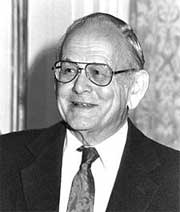 Some 40 years ago, Professor Garrett Hardin described the Tragedy of the commons using the hypothetical example of sheep in Scotland in the 19th century. Local herders share a pasture. The wool and meat from their sheep is selling well, they wish to increase their herd size and maximize their yield. More animals means more profit but each additional animal further degrades the pasture which is bad for all herders using the same pasture. However, the rational choice of an individual is selfish and stimulated by short-term gains, they won’t let themselves be worried by what is best for the whole herder community and their behaviour will eventually lead to the destruction of the resources on which they all depend.
Some 40 years ago, Professor Garrett Hardin described the Tragedy of the commons using the hypothetical example of sheep in Scotland in the 19th century. Local herders share a pasture. The wool and meat from their sheep is selling well, they wish to increase their herd size and maximize their yield. More animals means more profit but each additional animal further degrades the pasture which is bad for all herders using the same pasture. However, the rational choice of an individual is selfish and stimulated by short-term gains, they won’t let themselves be worried by what is best for the whole herder community and their behaviour will eventually lead to the destruction of the resources on which they all depend.
The solution Hardin proposes to the drama of open access is to impose an external governing structure to manage the fields. What started with a few sheep in Scotland had a big impact on our vision of the world and on the way to manage the commons.
The story doesn’t stop there, the government having shown his lack of competence to manage the commons, the ideal solution would involve privatization of the Commons.
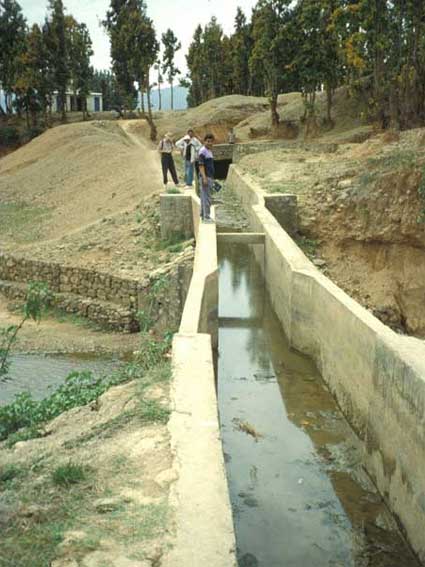 Cement-lined canal and cross-flow system in the Chiregad irrigation system in Nepal (image)
Cement-lined canal and cross-flow system in the Chiregad irrigation system in Nepal (image)
Fortunately, some people saw the glitches in Hardin’s stark statements and they started to analyze other systems. The case study of a farmer-managed irrigation system in Nepal proves the unreliability of Hardin’s view. Farmer-constructed canal which seem rather simple and primitive were actually much more efficient that the ones built for efficiency with a greater expense of money by the Nepal government. The traditional ones irrigated more crops than the newly constructed, government-owned ones. The infrastructure was old-fashioned but they were better managed. The problem didn’t lay in the engineering but in the way the canals were managed. The new infrastructure that came with government ownership had the effect of destroying the traditional rules established over generations to manage common resources.
The Nepal example and many other have shown that the Commons can also be managed efficiently using methods which do not have to involve privatization or government-ownership of the resources.
An excess of regulations actually leads to another tragedy, the Tragedy of the Anticommons. The term was coined in 1998 by Michael Heller, a professor at Columbia Law School. In his papers Can Patents Deter Innovation? The Anticommons in Biomedical Research and Do Formal Intellectual Property Rights Hinder the Free Flow of Scientific Knowledge? An Empirical Test of the Anti-Commons Hypothesis, Heller argued that patents are an obstacle to innovation and sharing of knowledge in science. Biomedical research is one of the key areas where competing patent rights could prevent useful and affordable products from reaching the marketplace.
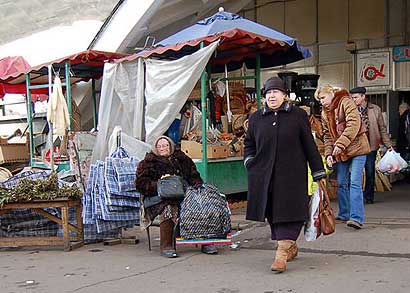 Image BBC news
Image BBC news
Heller also observed public spaces as his paper The Tragedy of the Anticommons: Property in the Transition from Marx to Markets demonstrates. His essay wonders why many storefronts in Moscow are empty, while street kiosks are full of goods? Heller observed that in post-Communism Moscow there were a lot of open air kiosks, but also a lot of empty stores. He concluded that in the transition from Marxism to capitalism, those commercial spaces had been over-regulated making it difficult for a startup retailer to successfully negotiate for the use of that space.
Lawrence Lessig mentioned and commented on Heller’s paper and even transfered the discussion about the commons from biomedicine and public space to internet and knowledge. The concepts of Commons and Anticommons are thus far from obsolete and internet has revived their relevance.
What happens to today’s public space? Do they suffer from a tragedy of the Commons or of the anticommons? Are we over-exploiting them or are they paralyzed by an excess of regulations? Have good old public spaces stopped to be useful and functional, do they still bring an added value to the life of citizens?
We often wonder why people attend a particular space rather than another one and how they use that space. Public spaces are often designed from top down with little attention on how citizens will eventually use them which will obviously lead to yet another example of the tragedy of the anticommons.
The first image Juan Freire used to illustrate his point was made by Nicolas Nova in Amsterdam. It shows a street that “defends itself” with elements that prevent people from using the street. This is a case of anticommons.
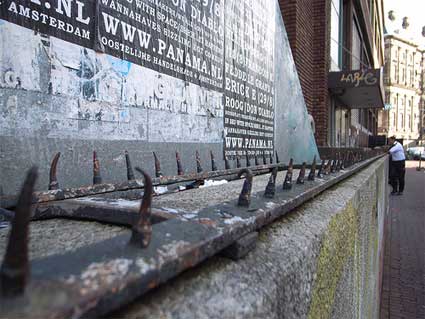 Photo Nicolas Nova who has more images and thoughts
Photo Nicolas Nova who has more images and thoughts
On the picture below, congested traffic in the streets of Bangkok. This looks like an example of the Tragedy of the Commons. The excessive use of a road that everyone is free to ride makes the road useless, annihilates the public space.
 Image source
Image source
The problem is that we haven’t progressed much since the 19th century, which is when an article published in the magazine of the Franklin Institute showed up. Titled On the Best Arrangement of City Streets, the publication(image) gave an example of excessive planning which forgets the role and needs of the citizen. A drawing and two pages of text describe a mathematical formula, an urban science, that ensures the “right” agency of the streets. Such magical formula can lead to an under-used public space. Unfortunately, on a certain number of aspects, we haven’t found a method that improves the 1877 drawing.
There’s another problem:
Can the ineffectiveness of the “analogical” public space, which we can also call the analogical procommon, be explained by privatization? Many people complain that public space is useful and well designed but because there is a Wal-mart or a Carrefour in the neighbourhoud, we desert public spaces and go to Carrefour (or Wall-mart). Freire believes that that vision needs to be nuanced. Such vision is the one of someone who looks for someone else to blame, does not assume any responsibility and does not even try to solve the problem.
Why is that so? Despite the fact that we live in a capitalist system, there are antagonistic concepts of capitalism but there are also models of capitalism which, although they are very antagonistic, coexist in the same space: the oligarchic model, the State model, the bureaucratic model. They don’t really follow the rules of the market. There’s a whole structure that prevents the market economy to function properly or that allows it to function only for a few entities.
But there is now another form of understanding the market and it’s brought to us by internet. “Markets are conversations.” The market here is seen as a deliberate form of aggregation of information, debate, decision making, deliberation between individuals. This is of course an ideal vision of how the market should function and it takes life when a series of barriers of access disappear or when a system enables information to flow freely and be accessed by everyone.
See Good Capitalism, Bad Capitalism, and the Economics of Growth and Prosperity, by William J. Baumol, Robert E. Litan, and Carl J. Schramm.
The solution is not only to eliminate “bad” capitalism but the alternative is “good” capitalism, the one that envisions market as a conversation. That’s where internet plays a key role, it eliminates those barriers and when it functions properly, it enables this idea of perfect markets with information that goes both way. This model is hypothetical but we are getting closer to it.
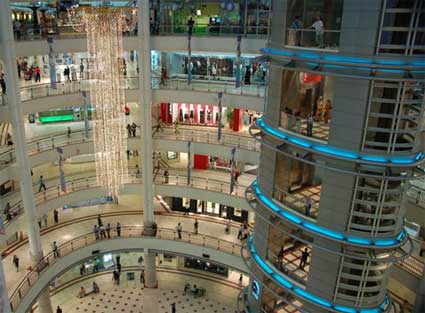
The public spaces we inherited from the 19th century can be called modernist. They were designed from top down, by an elite that cared for the wellbeing of the citizens yet, they have failed under several points of view. Those public space have given way in the 20th century to what we can call the Post-Modernist Public Spaces (even if the expression is questionable). They emerge as an answer to the obsolescence of the previous ones. If people are not going to the public spaces anymore, new -and this time private- opportunities are created for them: the shopping malls, the perfect example of post-modernist public space.
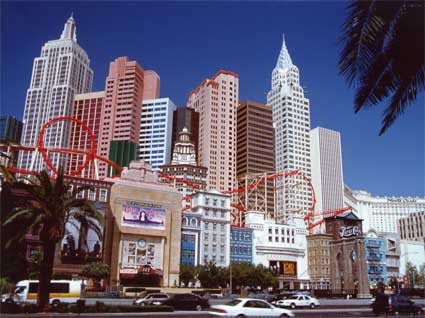 Las Vegas
Las Vegas
Many people believe that cathedrals have been substituted by shopping malls. For many they are only simulacra of the city. The acme of this idea is Las Vegas. A project of creating a new Las Vegas in Los Monegros (Aragón, SP) could turn out to be an interesting experiment. The shopping mall is the mirror of the society of spectacle. Shopping malls are the new public spaces but not all evil comes from them: in many cases we use them because we don’t have alternative or because they represent the best alternative at our disposal. Private initiative, in some cases, has managed to provide us with what public spaces designed by the State have not offered us.
The next question is therefore: How can we take back those old public space and update them? What is left of them?
Berkley University urbanist Christopher Alexander has written: For centuries, the street provided city dwellers with usable public space right outside their houses. Now, in a number of subtle ways, the modern city has made streets which are for “going through,” not for “staying in.
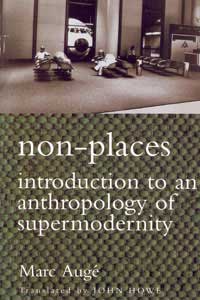 The traditional public space, made of squares and streets, have become what anthropologist Marc Augé calls the “Non-Places”. Rem Koolhaas goes further by christening them as Junkspace. In the post-modern vision, we move from private space we have to pay for and, as they are often located outside city centers, we have to drive through junkspace, non-places, spaces which have no immediate utility. The problem in the scenario is that interaction seem to have vanished. Social networks have shrunk to our own family circle or to shopping malls. A huge part of social interaction is missing. Are we ready to loose it? If we translate the scenario to the internet we have to imagine an internet where we can only find a commercial space and all the rest will just be junkspace.
The traditional public space, made of squares and streets, have become what anthropologist Marc Augé calls the “Non-Places”. Rem Koolhaas goes further by christening them as Junkspace. In the post-modern vision, we move from private space we have to pay for and, as they are often located outside city centers, we have to drive through junkspace, non-places, spaces which have no immediate utility. The problem in the scenario is that interaction seem to have vanished. Social networks have shrunk to our own family circle or to shopping malls. A huge part of social interaction is missing. Are we ready to loose it? If we translate the scenario to the internet we have to imagine an internet where we can only find a commercial space and all the rest will just be junkspace.
To put the finishing touch to the panorama we cannot leave aside the issue of publicity. The spaces between the private spaces we shop to, those junkspaces, are getting filled with advertisement. The vision about publicity is usually very critical and negative. When the Mayor of Sao Paulo in Brazil decided to eradicate any kind of advertisement in the city, his move has been welcome with not only wonder but also praise. Sao Paulo is the third city in the world. It counts almost 11 million inhabitants. Citizens, foreign observers, the press applauded the measure. Those who live from the revenues of publicity were less enthusiastic about it. But to which extent isn’t publicity part of our genome, of our ADN today? If you look at photos and videos of Sao Paulo without its billboards and advertising posters you get a slightly deshumanized vision. The structures that supported advertising are still there but they are empty, switched off. The buildings do not seem to be complete anymore. It seems that a crucial part of the city has been lost in the process. Maybe this effect is only transitory.
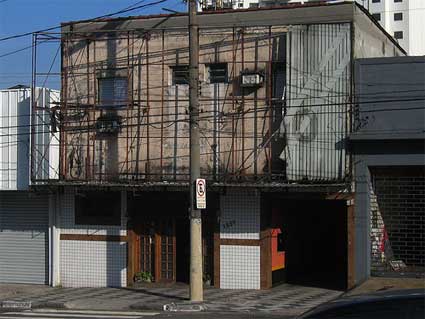 Image Tony de Marco
Image Tony de Marco
The following question is:
To what extent can we say that publicity is not part of our public space? And of ourselves?
The answer is not clear of course.
Do public spaces still exist? Or are we left with only post-modernist spaces, connected between themselves by non-spaces or junkspaces?
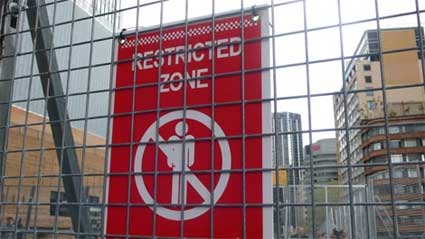 Image city of sound
Image city of sound
Freire illustrated the point by making an exercise of inverse engineering. The case study is the APEC (Asia-Pacific Economic Cooperation) Summit which took place last year in Sydney. It shows clearly what remains of a city when access to all public spaces is prohibited. All the security measures were taken to ensure that the event, the most impressive gathering of Heads of State the city had ever witnessed, would unfold without any glitch. Two blogs such as Subtopia (Fenceland and Subverting “Military IKEA”) and City of Sound (The Anti-Fun Palace: APEC Fence, Sydney lockdown) documented and analyzed quite shrewdly what happened in a city where access to public space was negated to its inhabitants, where extreme measures of security bring a whole city to a standstill with, for example, a 5km fence surrounding the Opera House area and Google Earth/Maps images of the area (and others) being blanked out or blurred. Important zones of public use where most of the city life was usually concentrated were militarized, closed down or saw their access strictly restricted.
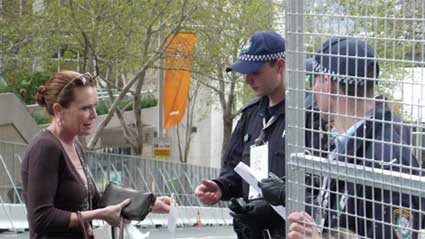 Image city of sound
Image city of sound
Streets, bike lanes, jogging tracks were closed, spaces where people would go to meet and chat were unaccessible. Fences had taken over the city. What is interesting is what you cannot see in the pictures collected by the bloggers: a way of living in the city being destroyed. When the public space and even the junkspace are eliminated from urban life, the city changes radically. Although we tend to be very critical of the way public space is deteriorating, is becoming useless, etc. reality is that public space is still a fundamental part of the city and not only as place of transit from one shopping mall to our house. By making this forced exercise of inverse engineering, we discover the value of places and things we have stopped to pay attention to.
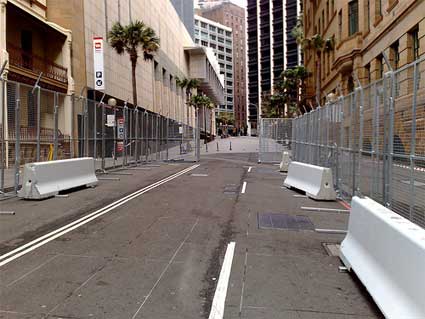 Image subtopia
Image subtopia
What is a public space? It depends on the capacity of auto-organization but also on market and community management
Public space depends on the capacity of auto-organization that we have. We must see further the concept of public space designed by the government for the citizen. The space cannot really be public if it doesn’t come with a certain capacity of self-management. Public spaces are hybrid, they combine market with community processes. The Common is much more sophisticated than we might think.
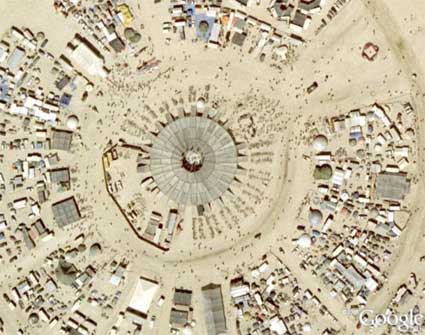 Image Google earth Burning Man
Image Google earth Burning Man
A fascinating exploration of public space is Burning Man. An outsider who attended the Fallas in Spain compared them with the Nevada-based festival. The former is organized by the State. Just after the party, the streets are filthy, there are traces of chaos all over the city. Burning Man instead is built and de-constructed by the community of participants without any top down supervision. After the party, the desert is left to its pristine state. No trash is left, the space is clean. The process is totally self-organized. The Burning Man community is able to create a public space which is not only dynamic but also ordered.
Burning Man is a public space that lives at the margins of Hardin’s theories.
Burning Man Time Lapse video
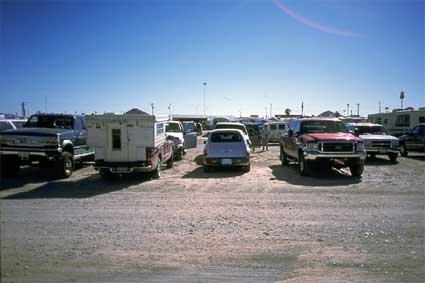 Image polar inertia
Image polar inertia
Another example is Quartzsite (Arizona) which functioning and dynamics have been described in Kazys Varnelis and Robert Sumrell’s book Blue Monday: Stories of Absurd Realities and Natural Philosophies (i’ll join Juan Freire in his enthusiasm about the book, it’s a gem.)
Quartzsite is a desert town of some 3,000 people that every Winter swells to over a million residents (making it the 15th-largest city in the USA) as a horde of modern nomads descends upon it in their motorhome. With very little planning, they create a city which works perfectly, it has its own dynamics, its own market (unlike Burning Man, there is a money-based economy), exchanges of goods and services, etc. It is spontaneous, yet very efficient.
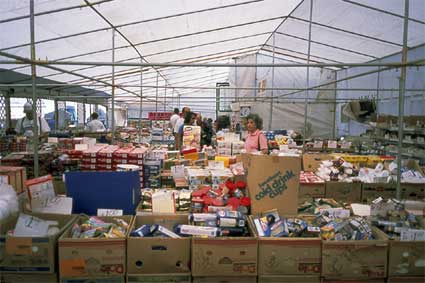 Image polar inertia
Image polar inertia
As Freire added, this is not the future of our cities but, making once again some exercises in reverse engineering, there are a few lessons that can be learnt from the Quartzsite experience. People as a group have far more intelligence than most would suspect. Sumrell and Varnelis call it ‘swarm intelligence’ – a human version of the behaviour often seen in ant colonies and the like.
Juan Freire then illustrated how hybrid a public space can be by showing us the main square of his city, A Coruña (Spain)
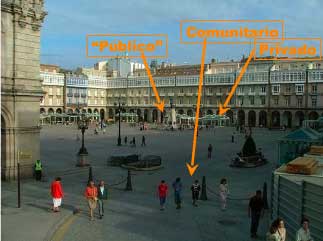
Public space functions quite well, it’s a very active area of the city. The secret to its success is the mix of private, community and public initiatives which take place on the Square. To be lively a square needs bars and there are plenty of bars here. There is also some space for people to self-organize and develop freely their own activities in a way that neither a bar nor a shopping mall can provide. The other requirement is some entity to think and design the whole experience and to create some urban furniture and other elements susceptible to foster all those activities.
Internet is the element missing from today’s equation. We cannot leave the internet aside anymore when we discuss public space. We live in a networked society. Many people say that we live both a physical life and a virtual life but Freire thinks that these two realities are getting more intertwined every day.
The networked society opens a new Commons. People don’t call it this way but the digital element is nevertheless essential. Internet was designed to be free and the knowledge that comes with it should be free as well. Although there is a huge amount of effort from above (copy right) to prevent knowledge from being free, it is nevertheless freeing itself.
We should see beyond the modernist vision of a traditional, well-planned public space. Today we are living a reality which is quite complex, hybrid and multi-faceted. Freire calls it an hyper-reality (in the “hyper-link” sense). Our public space today is hybrid in two ways:
– its environment is both physical and virtual,
– its management which is public, private and community-based at the same time.
Freire believes that we can achieve this hyper-reality through a re-appropriation of public space. 4 key elements will help us get there:
1. free knowledge,
2. free electro-magnetic space,
3. a post-spectacular architecture,
4. a digital skin layered over tarmac and concrete.
A few words about Free Knowledge, starting with a quote from Stephen Downes: The greatest non-technical issue is the mindset. We have to view information as a flow rather than as a thing. Online learning is a flow. It’s like electricity or water. It’s there, it’s available and it flows. It’s not stuff you collect….
Many people are horrified by the fact that knowledge flows continuously. They wouldn’t have any qualms about electricity flowing around us freely but they find the idea of a never stopping flow of information highly disturbing. They would like to be able to control it, to store it on the shelves of a library. But that’s a lost battle because information is going to increase more and more every day. An you know what? That’s a good thing. Especially if we manage to become curators of information. “We”, the users, not the so-called experts. We must become “digital chefs” and cook delicious dishes of information. The ingredients are out there on the web, the kitchen is packed with instruments which are free, or very cheap even when they come from some private or commercial initiative like Yahoo! or Google.
The second element we need is what Jose Luis de Vicente calls the “free spectrum“, we need to reclaim the use of the electromagnetic space. We need these electromagnetic infrastructures, no matter how intangible they are. As JL de Vicente wrote: “The radio spectrum – the electromagnetic space through which radio and TV broadcasts, mobile phone and GPS signals and WiFi networks circulate – is the real estate of the information society.” We can’t guarantee the freedom of information if we can’t control the structure that gives us access to it.
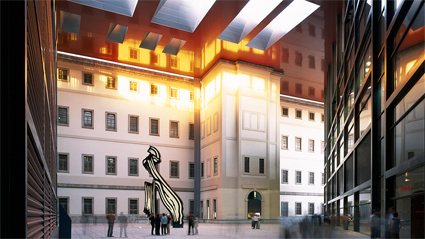 Reina Sofia Museum Extension, Madrid. Photo: Philippe Ruault (via arkhitekton)
Reina Sofia Museum Extension, Madrid. Photo: Philippe Ruault (via arkhitekton)
Thirdly, we need those architects whom Freire calls the “post-spectacular architects”. Sure, we like the architects of the “spectacular”, we like Frank Gehry’s Guggenheim, Moneo’s addition to the Prado, Jean Nouvel’s extension of the Reina Sofia, etc. But these spaces have not been designed for physical nor digital interaction. We need architects who think from the perspective of the people who will “use” the spaces, not just the tourists. But how should we design with a perspective of participation? The focus should be less on the aesthetics and more on the efficiency and on the functionality (what are we building for?) These ideas won’t lead to an anti-aesthetics but to a new form of aesthetics. This aesthetics will not only be better suited to our requirements but it will also start adopting something of the open source philosophy, by sharing designs, methods, etc.
Besides, this architecture will be cheaper and faster. The main problem is that cities change very slowly. We live in the same Madrid as centuries ago, even if society is not the same as centuries ago. Physical changes are way slower than intangible changes. We’ll never manage to keep pace with society’s changes but we can do something about it.
Freire gave a few examples of the kind of projects that he would like to see bloom over the cities, adding that some of them start to get out of the “workshops ghetto” and appear in glossy magazines:
– Ecoboulevard of Vallecas near Madrid, designed by [ecosistema urbano]. Fast architecture that solves several problems while proposing an innovative and appealing aesthetics.
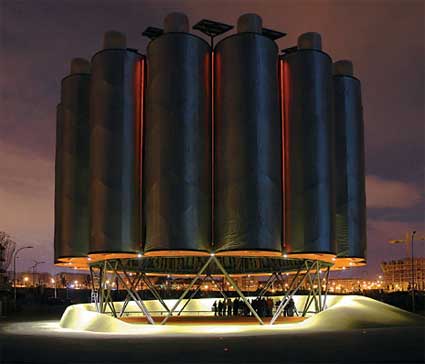 Ecoboulevard
Ecoboulevard
– Santiago Cirugeda‘s Recetas Urbanas (Urban Prescriptions). Cirugeda hacks the legal code. Because his home town would not authorize him to build a playground, Santiago Cirugeda obtained a dumpster permit and installed a playground that looked like a dumpster. He also built and occupied a rooftop crane that passersby believed was there only to move building materials. There used to be a video on you tube where the architect used Playmobil toys to demonstrate how to build a temporary flat in your rooftop. The solutions Cirugeda proposes are cheap, fast, accessible to everyone and the key ingredient is to find out the gaps in administrative structure and official procedures, to intervene where the law falls short.
Is Cirugeda doing art, architecture or activism? Probably the three of them but does it really matter?
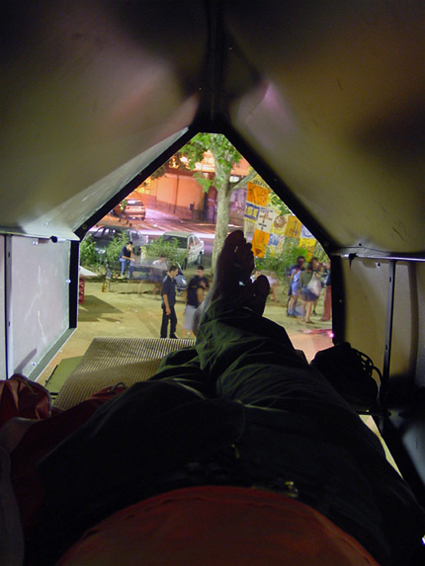 Inside Cirugeda’s insect house
Inside Cirugeda’s insect house
– Vicente Guallart whose work is more often found in museums than in the streets, probably because his vision is still too futuristic. His Sociopolis project is a neighbourhood designed with a mind set on efficiency, functionality, digital networks,
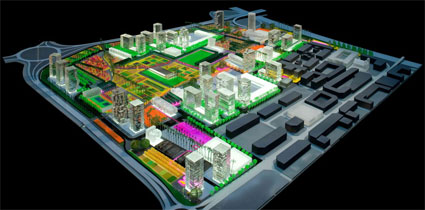 Sociopolis
Sociopolis
– Jose Perez de Lama, a member of the Sevilla-based collective hackitectura, believes that we need to build layers of digital information over physical spaces. Architecture, in its traditional definition, is relevant but not central. The space is built using mostly intangible elements: electronic flux, interfaces, audio, projections, words, bodies, landscapes, etc. We need to combine the tectonic with the electronic.
Hackitectura has illustrated their concepts with a series of interventions in public space. The most famous of which being the wikiplaza project in Sevilla which regards public space as multi-layered: there are bars, grass, cements and tarmac but there’s also the digital space.
Finally a bit of futuristic speculation. Future is in the hyperlocal networks. Paradoxically, internet has allowed us to be globally connected but it doesn’t help us enough when we want to be connected with what is in our own neighbourhood. That’s mobile telephony that we use (intensely) for local connections. The development of hyperlocal networks is a big opportunity, a double opportunity: both from the commercial and the citizen point of view.
Last July, Bruce Sterling wrote an inspiring article, Dispatches From the Hyperlocal Future. A protagonist narrates his life in 2017 and how he moves in those hyperlocal networks.
In the 20th century appeared the Situationists. Among their ideas was the Dérive, an invitation to use the city in a new way. The Situationists failed in their attempt to radically change the world but they manage to predict what the future would bring. We use more and more the city like they said we ought to. This concept of the city as a space for exploration is getting more and more appealing.
The hyperlocal networks are made of elements which are already existing around us but they still have to be connected one to another. However, every day new initiatives appear that tell us that the situation is about to change. Here’s a rapid list of projects which Freire find as thought-provoking as inspiring. They might seem to be disconnected but if you put them together in a broader picture, you’ll see glimpses of a new reality emerge.
– hyperlinks with physical space, like google maps.
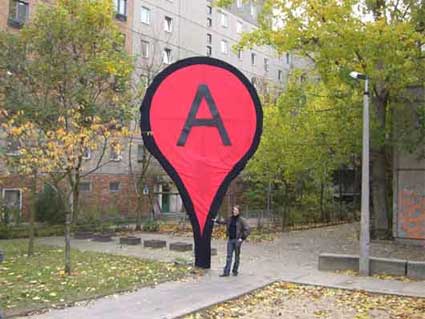 Aram Bartholl‘s project The Map
Aram Bartholl‘s project The Map
– the concept of ubiquitous computing which highlight the upcoming urbanism 2.0, cf. Adam Greenfield‘s essay Everyware.
– mobile internet, ubiquitous connectivity (ex. urban tapestries).
– the internet of things, of objects, what Bruce Sterling defined Spimes back in 2004. More in his book Shaping Things.
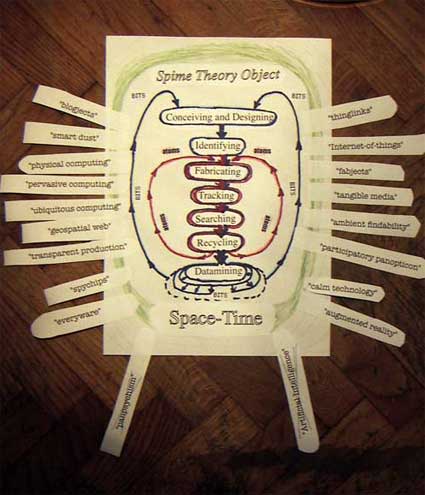 Image Bruce Sterling
Image Bruce Sterling
– new initiatives like Semapedia to hyperlink the whole world.
– new possibilities to visualize people and the flux of information in urban space. One of the most famous example is Real Time Rome, the MIT SENSEable City Lab‘s contribution to the 2006 Venice Architecture Biennale.
– collaborative cartography. Geographical information is still private and is often submitted to copyrights. People can view the database but they are not allowed to take the data and use them as they wish. Fortunately some initiative are attempting to put an end to the geo-monopoly. E.g. the open and collaborative OpenStreetMap.
– the mash-ups which use google tools to propose more personal visions of space. Besides, these mashups enable users to monitor what is happening in physical space right here and right now (to track fires in California for example).
All these initiatives demonstrates that we have the opportunity to layer a digital skin over the city. The skin is not just a fad, it will make the urban experience more meaningful and useful. E.g. Urban Tapestries, a research project born in 2003, Dodgeball, Outside.in which aggregates, tags and structures local information available online, using thus individual activities to build instruments useful for everyone.
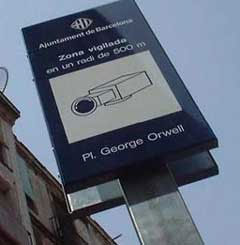 G. Orwell place, Barcelona
G. Orwell place, Barcelona
Freire, being the astute and realistic observer he is, also pointed out the darker face of public spaces by quoting Stephen Graham who wrote in Subtopia:
The real architectures of control already are algorithms, software, databases and microelectronic tracking systems, satellites and sensors, linked intimately to physical spaces, infrastructures and bodies, rather than the obvious architectonic brute force of walls and ramparts.
The future might be of the Orwellian type or it can be the one that Freire described in his presentation. It’s in the hands of citizens and whether they will adopt an active or passive role. Today we have the opportunity not only to protest but also to take things in our hands and push changes.
However, there’s another danger: the one created by people who do not understand internet. German philosopher and sociologist Juergen Habermas wrote that … in the context of liberal regimes, the rise of millions of fragmented chat room across the world tend instead to lead to the fragmentation of large but politically focused mass audiences into a huge number of isolated issue publics.
Freire believes that instead of just creating fragmentation, internet enable us to go beyond fragmentations.
Facebook, for example, counts many advantages but also many downsides. It’s a network you can close and keep for your friends exclusively
LifeAt creates private online communities for residential properties. It’s closed and “secure” with control over who has the right to use it and what can be published or not. There’s an absolute control over people and content. The model can be interesting for commercial companies or for facebook but in the context of public space, it would do more harm than good, it would mean applying post-modern concepts to new hybrid space.
As a conclusion, Freire quoted an article that urbanist José María Ezquiaga wrote for national newspaper El Pais. He adopted the Mai 68 moto “Sous les pavés la plage” (Under the cobblestones lies the beach) to tell us that we have to see beyond the ugliness of cobblestones and uncover the beaches that exist beneath them. Freire added, this time quoting Jose Pérez de Lama, that above the tarmac there is a digital layer. Although that layer is neither tangible nor visible, it set to fulfill a crucial role. If we use this additional layer intelligently and openly, then the future might indeed be appealing.
The Q&A which followed was almost as fascinating as the presentation itself but i’m done with the translation.

